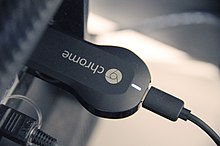Dongle

A dongle is a small piece of hardware that connects to another device to provide it with additional functionality. In relation to computing, the term is primarily associated with hardware providing a copy protection mechanism for commercial software—in which the dongle must be attached to the system that the software is installed on in order for it to function.
The term "dongle" is also associated with similar devices meant to provide additional forms of wireless connectivity to devices (such as Wi-Fi or Bluetooth support), often over USB connections, as well as small digital media players (such as Amazon Fire TV Stick, Chromecast, and Roku Streaming Stick) and personal computers (such as Chromebit and Intel Compute Stick) meant to plug directly into an HDMI input on a television.
Examples of dongles
Copy protection
- The CD-based parts catalog (known as "ETKA") used by Volkswagen Group used since 2000 requires a coded dongle be plugged into a host computer's port in order to run.
- Some professional digital audio workstation packages on the Atari TOS platform required the presence of the supplied dongle in the computer's cartridge port in order to run. Steinberg's Cubase range and C-Lab's Creator and Notator packages frequently send data to the dongle, which sends a response determined by the electronics inside the cartridge.
(The additional expense of producing the dongle was justified by the high purchase price of the software (hundreds of British pounds) and the tendency for unprotected software to be subject to piracy. To ensure compatibility with MIDI and other audio expansion units that also occupy the single cartridge port, some dongles had a pass-through connector to accommodate them. Some expanders were also designed with backplane sockets to host the different dongles unique to a specific set of packages. Eventually, software pirates were able to circumvent the dongle scheme by modifying the program's binary to accept simulated dongle responses, at the expense of stability and performance.)[citation needed]
Copy protection circumvention
- Some unlicensed game cartridges have a "daisy chain" that allows licensed games to pass along their authorization, for instance to circumvent the 10NES chip on the Nintendo Entertainment System.
Small peripheral appliances

- Small devices that plug into other equipment to add functionality are often referred to as dongles; for example the infrared remote control adapters available for smartphones, or digital media players such as Chromecast.
- MHL. A dongle enables adaptation to legacy standards such as HDMI via conversion circuitry contained in the dongle itself. MHL dongles often allow USB connections and/or device charging as well.
Adapters
- Very short cables that connect relatively large jacks to smaller plugs allowing cables to be easily installed and removed from equipment with limited space available for connectors. The Chromecast device mentioned above, for example, comes with a short HDMI extension cable to allow its use in cramped quarters. Some devices come with a permanently attached length of cable that negates the need for a short adapter cable.
Adapters for the MacBook
- MacBooks use a single USB-C connector for its design advantage, and employ a variety of dongle-like adapters for interfacing with larger connectors, such as the USB-A connector, FireWire, Ethernet, VGA, HDMI, and Thunderbolt, amongst others. Apple has traditionally received criticism for preemptively abandoning legacy ports over the years in favor of having newer technology on on its older products sooner, and has released different forms of these adapters over time with the introduction of new technologies.
Other
- Cassette adapters enable cassette-radios to allow AUX in, like with iPod/MP3 player/smartphone (portable CD players before 2000)
- Personal FM transmitters allow content from a portable media player, portable CD player, smartphone, portable cassette player, or other portable audio system to be heard on an FM radio.
- IDE/PATA connectivity can be re-channeled with some dongles:
- Floppy disk drives have been emulated on solid-state "dongles" to ensure legacy recognition, allowing SD cards to serve software to old Commodore 64 and Apple II era computers.
- Allows SD cards to be recognized as "hard drives" on old DOS computers
- Old school video game consoles:
- The Everdrive series of game cartridges has enabled classic systems such as the Sega Megadrive and Nintendo 64 to allow one cartridge to have a number of games that were formerly on multiple cartridges of their own, by use of an SD card with ROMs on them; since it can allow a real game console to access ROMs, which an emulator would normally do.
- The Sega 32X was an add-on for the Sega Mega Drive which allowed a 32-bit library of games to play on a system that was normally just 16-bit, though it suffered from having its own video output, and its own AC adapter in order to work.
- USB host connectivity grants more flexibility to computer-based devices
- Bluetooth
- legacy game controllers have special adapters
- SD card readers
- Flash drives
- Older cars that "externalized" their CD players and changers from the head unit can now use "emulators" that allow USB and SD cards with MP3s and other audio files to be recognized as "tracks" to the CD control unit circuitry.
- Adapters that convert miniature implementations of an interface to the full-sized equivalent, or are required to provide the electrical and mechanical interfaces for expansion cards that cannot physically accommodate them (such as PCMCIA, Compact Flash and ExpressCard expansion cards which are just millimetres thick, too small for a standard connector without having the connector and housing extend beyond the dimensions specified by the standard). Although commonly referred to as "dongles", the alternative term "Pig-tail" is favoured by some in the IT industry, due to the appearance of a full-sized connection element, with a short, thin wire extending, somewhat reminiscent of the rear of porcine animals. The term is somewhat descriptive, and allows one to avoid using the word dongle except for its original meaning.
